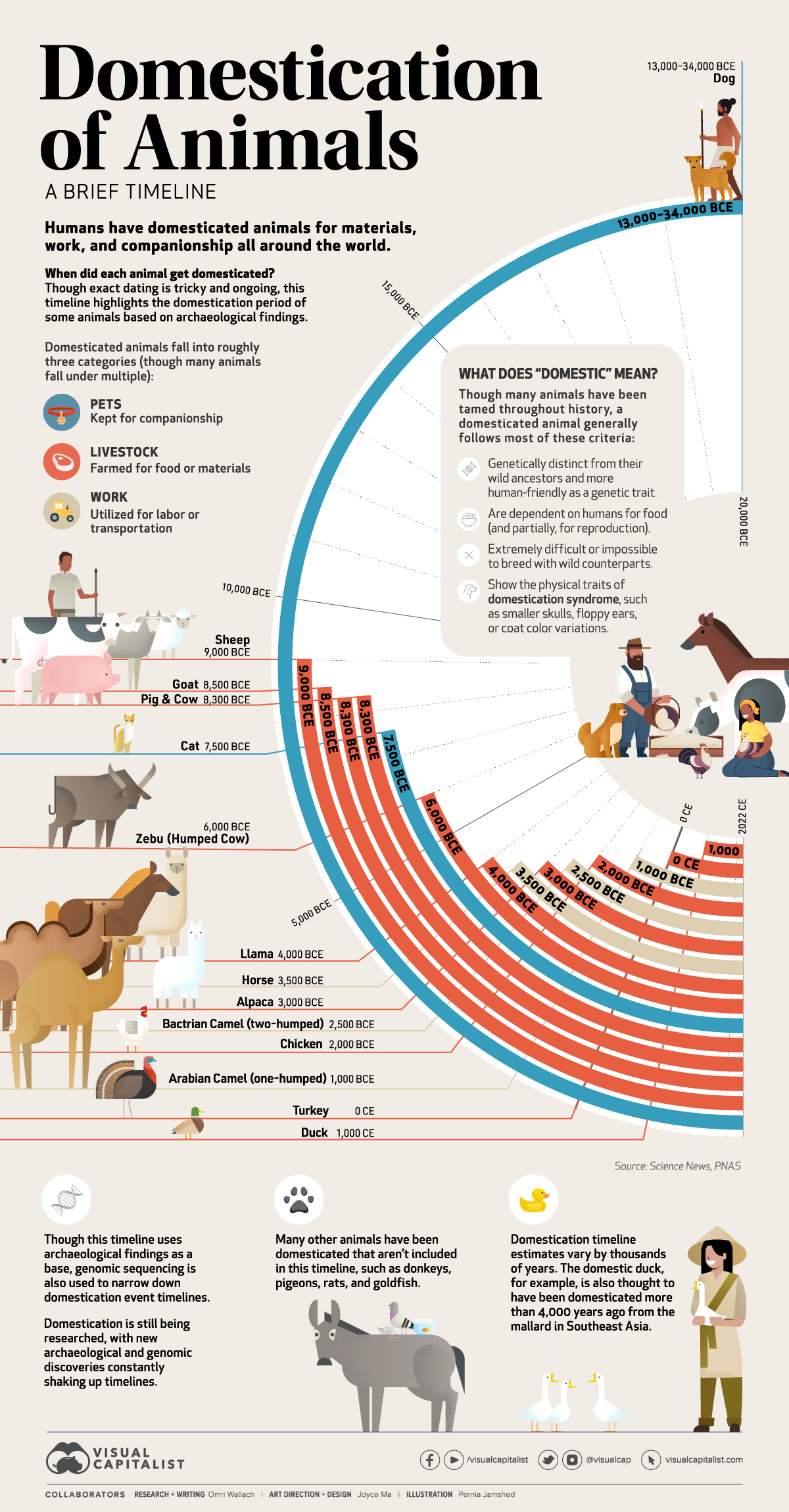Timeline: The Domestication of Animals


Timeline: The Domestication of Animals
While dogs weren’t always our docile companions, research indicates that they were likely one of the first animals to be domesticated by humans. In fact, genetic evidence suggests that dogs split from their wild wolf ancestors around 33,000 years ago.
When did humans domesticate other animals, and why? This timeline highlights the domestication period of 15 different animals, based on archeological findings.
Because exact timing is tricky to pinpoint and research on the topic is ongoing, these estimates may vary by thousands of years.
Defining Domestic
The domestication of animals is a particular process that’s done through selective breeding. Generally speaking, domestic animals follow most of these criteria:
- Genetically distinct from their wild ancestors and more human-friendly as a genetic trait.
- Dependent on humans for food and reproduction.
- They’re extremely difficult or impossible to breed with wild counterparts.
- Show the physical traits of domestication syndrome, such as smaller skulls, floppy ears, or coat color variations.
Domestication is not the same as taming an animal, which is when humans condition wild animals to live in captivity.
While some research suggests that domestic animals can prosper in the wild, domestic animals are typically more susceptible to predators since they lack some of the advantages, instincts, or traits that help their wild counterparts survive in nature.
Key Reasons for the Domestication of Animals
Humans domesticate animals for a number of reasons: some have been domesticated for food, work, companionship, or a combination of all three.
After dogs, livestock animals such as sheep, cows, and pigs are thought to have been some of the first animals to become domesticated by humans. This was around the same time that humanity shifted from a hunter-gathering lifestyle to an agricultural society.
| Domesticated Animal | Primary Type | Estimated Domestication Period | Origin |
|---|---|---|---|
| Dog | Pet | 13,000–34,000 BCE | Eurasia |
| Sheep | Livestock | 9,000 BCE | Middle East |
| Goat | Livestock | 8,500 BCE | Middle East |
| Pig | Livestock | 8,300 BCE | Middle East |
| Cow | Livestock | 8,300 BCE | Middle East |
| Cat | Pet | 7,500 BCE | Middle East |
| Zebu (Humped Cow) | Livestock | 6,000 BCE | South Asia |
| Llama | Livestock | 4,000 BCE | South America |
| Horse | Work | 3,500 BCE | Central Asia |
| Alpaca | Livestock | 3,000 BCE | South America |
| Bactrian Camel (two-humped) | Work | 2,500 BCE | Central Asia |
| Chicken | Livestock | 2,000 BCE | East Asia/Middle East |
| Arabian Camel (one-humped) | Work | 1,000 BCE | Middle East |
| Turkey | Livestock | 0 CE | North America |
| Duck | Livestock | 1,000 CE | East Asia/Middle East |
Horses are thought to be some of the first animals domesticated for work. Scientific research suggests that the modern horse originated in Central Asia, and were selectively bred for their exceptional back strength and overall resilience.
When it comes to domesticating animals, herbivores (like cows) are generally the easiest to convert because they’re easier to feed than animals that rely on meats or grains, which need to be sourced or domesticated themselves.
Domestication Has Shaped Modern Humanity
The domestication of species has helped create our modern society. Domesticating plants and animals created a world with stable food production, which enabled the human population to boom worldwide.
This is because agriculture meant fewer people could provide more food to humans on a mass scale, so people had more time to focus on other things like creative pursuits, scientific research, etc. This gave us time to create tools that helped boost efficiencies in farming and agriculture, leading to the world as we know it today.
The post Timeline: The Domestication of Animals appeared first on Visual Capitalist.


